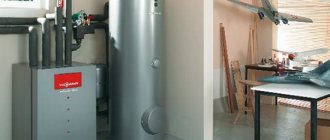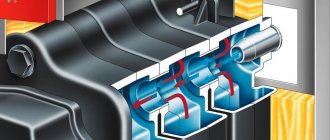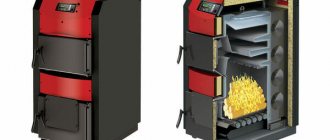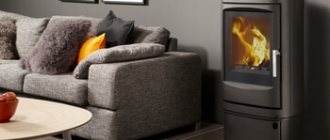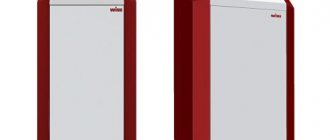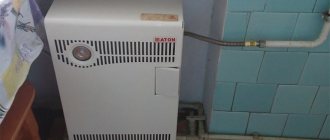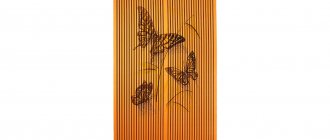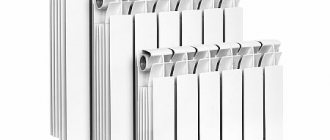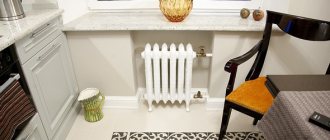A full-fledged autonomous heating system will be such only in one case - if the boiler does not depend on the energy carrier. Electricity and natural gas are supplied centrally; the distribution company can stop providing services at any time.
Liquefied gas and diesel fuel have a high price and require a complex storage system. A boiler that receives energy from the combustion of solid fuel will help make the system autonomous.
The equipment runs on wood, coal, peat, and pellets. These are accessible and inexpensive types of fuel. The best solid fuel boilers are highly efficient, do not require constant user attention and are safe. The rating compiled by our team will help you choose such equipment.
Rating of the TOP 10 best solid fuel boilers for heating a private home in 2021-2022
| TOP 3 best solid fuel boilers by price/quality for 2021-2022 | ||
| 1 | Protherm Beaver 50 DLO 39 kW | Find out the price |
| 2 | Teplodar Cooper Praktik 8 | Find out the price |
| 3 | ZOTA Box 8 8 kW | Find out the price |
| TOP 3 best long-burning solid fuel boilers | ||
| 1 | ZOTA Topol-22VK 22 kW | Find out the price |
| 2 | ZOTA Topol-16VK 16 kW | Find out the price |
| 3 | ZOTA Topol-32VK 32 kW | Find out the price |
| TOP 2 best solid fuel boilers with a water circuit | ||
| 1 | ZOTA Topol M 14 14 kW | Find out the price |
| 2 | Lemax Forward-16 17 kW | Find out the price |
| TOP 2 best pyrolysis solid fuel boilers | ||
| 1 | Bourgeois-K MODERN-12 12 kW | Find out the price |
| 2 | TRAYAN T-20-1KT | Find out the price |
Reviews of household solid fuel boilers: advantages and disadvantages
| Advantages | Flaws |
| Cheapness and availability of both boilers and fuel, “omnivorousness” of most models. The operating costs of solid fuel boilers are also among the lowest, lower only for gas and some liquid fuel boilers | The need to organize a seasonal warehouse for fuel storage, which means additional space, effort and expense |
| Reliability and simplicity due to the simple design, in which most often there is simply nothing to break | The need for constant monitoring and management. Even long-burning boilers require regular refilling of firewood, manual ignition and constant monitoring, not to mention classic inexpensive models |
| Installation of a TT boiler does not require approval or permitting documentation, as is the case with gas or electricity | Transportation, storage and combustion of solid fuels involves increased indoor pollution and a characteristic odor, especially when burning coal. |
| Prices for the most budget wood-burning models start from 12-14 thousand rubles | According to owner reviews, the prices for more technologically advanced and automated models are quite high, paying off for at least 5 years. |
| Independence from external factors, most models are non-volatile | |
| A huge selection of models for any budget and functionality, the availability of single-circuit and double-circuit models, as well as automated boilers that practically do not require human intervention | |
| Easy to use and maintain. Heating and cleaning modern solid fuel boilers is much easier and more comfortable than older models |
How to choose a solid fuel boiler
Heating equipment must be reliable, economical, and capable of maintaining an optimal microclimate. Equipment that meets these requirements is offered by domestic and foreign companies.
Which solid fuel boiler is better for a private home, and which can only cope with heating a small cottage, depends on a number of parameters taken into account when choosing a model.
Thermal power
You can buy a small, inexpensive boiler, but you need to take into account the power of the equipment. Manufacturers must indicate this characteristic in the technical documentation. The maximum area of the heated room depends on the thermal power.
These parameters are directly related: per 1 kW there should not be more than 10 sq.m. premises with a ceiling height of 2.7 meters. For heating a small house of 60-70 sq.m. A boiler with a thermal power of 6-7 kW is sufficient.
Preliminary calculations are relevant for small buildings. More precise parameters should take into account the calorie content of the fuel used, the number of radiators installed, the presence of a boiler and its volume.
It is recommended to order a detailed calculation of thermal power from heating engineers. This will help get rid of problems during severe frosts or when using low-calorie fuel.
Efficiency
The ratio of consumed fuel to the amount of useful heat is called efficiency. There is no equipment with 100% indicators; heat loss occurs from underburning of the emitted gases, which corresponds to the appearance of soot. Part of the thermal energy goes through the pipe, the other is spent on heating the walls and heat exchange with the air of the room where the equipment is installed. Efficiency is reduced by raw fuel and improper air supply.
The maximum efficiency is found in pyrolysis-type models; it can be made higher not only by the high combustion temperature of the gases, but also by the complete combustion of the fuel. Manufacturers increase efficiency by installing combined thermal insulation, of which the water jacket becomes part - energy is spent not on heating the air, but on increasing the temperature of the water. The higher the efficiency, the more cost-effective the heating system.
Type of fuel
It is recommended to buy a boiler that runs on an available type of fuel. Automated pellet models are attractive due to their functionality, but if you don’t have access to pellets, you can end up in a cold house. Universal models operate on coal and wood. Coal burns longer, allowing you to spend a minimum of time on maintenance. Firewood is a more affordable type of fuel.
When choosing a wood-burning model, you should take into account the recommended log size and the ability to efficiently burn raw fuel. Pyrolysis boilers operate on dry wood. If it is not possible to store fuel in a room with normal humidity, then such equipment will have to be abandoned.
Heat exchanger material
Manufacturers produce models with steel and cast iron heat exchangers. Heat exchangers made of heat-resistant steel have low inertia, are easy to maintain, light in weight and resistant to mechanical damage. Steel can be used to make structures of any complexity and improve operating parameters. Disadvantages: short service life, risk of burnout and low corrosion resistance.
Cast iron sectional heat exchangers are resistant to corrosion, acids, and high temperatures. Good heat transfer allows the use of small sections. Cast iron is a brittle material that is not resistant to sudden temperature changes. Heat exchangers are heavy and have low efficiency.
Number of heating circuits
Models with one water circuit are intended for heating only. A double-circuit boiler will provide heat and hot water. These models are more expensive, so if necessary, it is better to use equipment with the ability to connect a boiler. Heating in the summer is not always comfortable; in this situation, a solid fuel electric boiler with a heating element will help out, which will maintain the desired temperature in the hot water supply system.
Steel or cast iron - which is better?
Solid fuel boilers are made from two types of metal alloys - steel and cast iron, and therefore there are ongoing battles on forums about which of these options is better.
Cast iron model
Opinions, as usual, are the most contradictory, and it is simply impossible to make an unambiguous verdict here.
Steel model
Let's still try to understand this issue, relying on the opinions of experts.
Table 3. Experts' opinion.
| Evaluation criterion | Pros and cons |
| Weight and transportation | A boiler with a steel body is lighter, so it is much easier to transport and carry it by hand. Cast iron is generally very heavy, and also fragile. Such a boiler must be moved very carefully, since after an impact it may not survive to the first fire. |
| Maintainability | The most common problem that occurs with cast iron boilers is a burst section that needs to be replaced. And here you can expect difficulties associated with ordering it and waiting for delivery - as well as with finding a technician who can replace it so that in the future the boiler, which needs to be completely disassembled, does not leak. On a steel boiler, at most, you may need to weld a seam, and any welder can do this. |
| Price and durability | If we compare two models with a similar design and power, then the cast iron one will be twice or even three times more expensive. Manufacturers and sellers explain this by a longer service life, which many experts strongly disagree with. And even if so, then for the amount you need to pay for a cast-iron model you can buy at least two steel ones, which in total will amount to the same period. And it is still unknown how many times during the entire life of a cast iron unit you will need to change its sections. So here the advantage definitely goes to the steel boiler. |
| Efficiency | About the same. However, cast iron is more massive and retains heat longer, while steel, although it heats up faster, also cools down faster. |
| Difficulty of installation | A cast iron boiler is more complex in installation, and any connection error can cost it its “life.” So here too it loses to its steel brother. |
Which solid fuel boiler is better
Replacing heating equipment during the height of the winter season can lead to serious problems. To prevent this from happening, you need to be careful when buying a boiler.
The equipment must run on accessible fuel, have simple and reliable functionality, and high efficiency. In this case, the property owner will be able to significantly reduce heating costs.
Our experts have analyzed the products of the best manufacturers and, depending on the specifics of use, recommend the following models:
- Zota Topol-16VK - a simple and economical model for a private home;
- Lemax Forward-16 17 kW - reliable equipment for the garden;
- Protherm Beaver 50 DLO 39 kW - an efficient boiler for a country house;
- Bourgeois-K MODERN-12 12 kW – compact equipment for a summer residence;
- Teplodar Kupper Praktik 8 is an economical boiler with a high degree of automation for a luxury mansion.
What kind of boiler should be capable of maintaining coziness and comfort in the house every day throughout the winter? Only the best models with easy maintenance and high energy efficiency can cope with this task.
Operating principle
Main stages
1. The boiler begins to work from the moment of ignition, when the temperature rises sharply to 600° in five to ten minutes. At the same time, according to the settings, the heat exchanger is heated to 40°-70°.
2. As combustion progresses, the temperature in the furnace increases to 1000°-1300°, and the heating of the coolant - water - reaches an operating value of no more than 95°, which is maintained by regulating the air supply into the combustion chamber with a valve.
Heating the coolant above 95° is dangerous for the system and can damage it!
3. After complete combustion with the formation of smoldering coals, the temperature slowly decreases.
Advantages
- Long-term autonomy with the possibility of use as a backup heat source during a power outage or gas supply.
- High efficiency factor (efficiency), reaching 85%.
- Long-term combustion mode using the resulting flue gas that supports the process.
- Cheap fuel, but with costs for transportation, loading and unloading, and storage.
- Reliability and long service life.
- Versatility.
- Simplicity of design.
- Lower price compared to other types of boilers (electric or gas) with the same power ratings.
Flaws
- The need for a dedicated room for the unit, as well as storage of supplies.
- Mandatory installation of a chimney.
- Labor-intensive operation for loading and cleaning from ash and soot.
Customer Reviews
Ignat K.
Protherm Beaver 50 DLO 39 kW
Advantages: It has been working since 2014 with virtually no complaints. At the same time, only one inspection took place (one year after installation). Disadvantages: It often turns on to maintain the temperature; it can turn on/off 2 times in 10 minutes. I would like to adjust the hysteresis of the tº spread. After 6 years, something began to squeak when the pump rotates. Comment: One winter it turned off with error F5 - problems with traction. After I removed the ice that had formed from the pipe (and there was actually a lot of it frozen after the snowfall and severe frost), the problem was solved. It seems to me that those who get their entire controller replaced for the F5 error are simply being scammed out of money.
Novel
Teplodar Cooper Praktik 8
Advantages: Electronic control. Quiet operation. Weekly timer Connection of an external thermostat Burner modulation Built-in expansion tank Possibility of using non-freezing coolant Disadvantages: Operation of an anti-freeze system. The manufacturer cannot provide information on the OpenTherm interface, which is declared in this boiler, and the equipment compatible with it. Comment: I was a little disappointed by the breakdown. Immediately after the initial startup, the system board needed to be replaced - the system did not see that the burner was lit. But the issue was resolved directly with the manufacturer. I received the new fee by mail 4 days after applying. I installed it myself. Everything has been working fine for a year now. The service is fine. Incomprehensible anti-freeze system. The pump turns on at +8, turns off at +12, and the burner turns on at +5. And if the temperature falls into the region of +10, then the circulation pump works for days. And if non-freezing coolant is filled in, then this system is not needed at all.
Vladimir Malvinov
ZOTA Box 8 8 kW
Advantages: Good and reliable boiler Disadvantages: I haven’t found it in a year Comment: On the advice of friends, we purchased a boiler. A voltage stabilizer was immediately purchased; in our village we have large power surges, the lights blink frequently. For almost a year of operation, the boiler has never been repaired, only scheduled maintenance. . The reliability and safety of the boiler is also at the highest level. Heat exchangers can withstand the test of fairly hard water. There are no complaints, we are completely satisfied with the purchase, everything is simple and clear. I advise you to buy!
Kirill M.
ZOTA Topol-22VK 22 kW
Pros: Excellent boiler. There are commissioning features. Reading the manual!!! By default, the turbo water heating mode is set, which is needed if you have a long distance from the boiler to the point of water consumption; the water is heated to 70 degrees immediately. If you have a bathroom behind a wall, it is better to turn off this mode in the settings. In the second mode, the boiler is set to maximum heating output, so if you place the boiler in a small room, it is better to also reduce the heating. This is important, and then you will be happy and there will be no problems with operation. And also, if there are problems with water pressure, then install a mixer with separate valves (do not install joysticks), but this applies to any boilers.
Vasily D.
ZOTA Topol-16VK 16 kW
Advantages: Relatively compact, somewhat stylish, the interface is clear from three notes Disadvantages: Not eternal Comment: I used it for two years and had no problems. Now I don’t know either, only the boiler has become a little louder. If I get tired of it, I’ll take it to the service center with a guarantee. I don’t really understand people who expect their systems to work forever and without problems, everyone’s water is different, and the hands of installers and servicemen are screwed differently every now and then. I took the extended warranty and can continue to live in peace.
Nikolay V.
ZOTA Topol-32VK 32 kW
Advantages: Reliability, functionality Disadvantages: Noisy Comment: Last year we selected a gas boiler for heating. We looked at more than one option and chose the Lemax Premium-30V boiler. We consulted with neighbors and gas workers. We looked on the Internet. Lemax is produced in Russia. This means they are adapted to our Russian realities, unlike imported ones. This is a floor-standing, double-circuit boiler with an open combustion chamber; combustion products are removed naturally through the chimney. It will heat the house and heat the water. Electronic control. The quality is top notch. This is confirmed by those who already use such boilers and those who service them. The boilers are reliable, and if something happens, they are repairable. Spare parts are always available and at low prices compared to imported ones. We ourselves were convinced of the quality of the boiler. Last winter, and it was frosty, he proved himself to be the best.
Ignatov B.
ZOTA Topol M 14 14 kW
Advantages: compact, does not require an electrical connection, economical, easy installation and management. Disadvantages: everything suits me, otherwise why would I buy it. Comment: If you are looking for a good, high-quality boiler that is easy to install and control, then Lemax Patriot-16 is the best choice. I installed it in my apartment and am completely satisfied with its performance and functionality. In addition, I began to pay several times less for heating when I connected autonomous heating and refused the services of the heating network. The boiler does not require connection to the electrical network, which was also important for me. And the fact that the boiler is floor-standing is also a small thing; it doesn’t take up much space and fits perfectly into the overall interior.
Mikhail D.
Lemax Forward-16 17 kW
Pros: Good appearance, not embarrassing to hang. Disadvantages: Error e48 Comment: Selecting a double-circuit boiler took a long time and painfully. In the end we settled on Lemax Prime-32. I liked the boiler for its unobtrusive appearance (it hangs on display) and the quality of its build. It works flawlessly, high-quality automation and reliable security systems are installed. At first, after starting there was a problem - the injector was burning with a red-blue flame, a service specialist was called. Even a child knows that fire should only be blue. The reason turned out to be excessive pressure in the system, after adjustment everything became normal. We are happy with the boiler; there is enough power for both heating and hot water.
Vladimir Malvinov
Bourgeois-K MODERN-12 12 kW
Pros: Yes, everything is good. Quiet, stable, I almost forgot about him that he existed. Disadvantages: EA’s favorite mistake, but it’s solved, I’ll tell you how below. Comment: I installed it at the dacha, connected it and configured it myself. Powered by LPG from a gas tank. Installed it, configured it according to the instructions and everything worked. A day or two and a “favorite” mistake. It starts up normally, then goes into it (I don’t know about others, but for me it popped up right at the moment the burner started). I started racking my brains. After a day of experimenting, I finally discovered the reason. The boiler starts up very smoothly and silently, the burner slats light up smoothly, one after the other. But!!! The burner igniter and the flame control electrode are located at the maximum distance from each other. As a result, sometimes the flame simply did not have time to reach the flame control electrode in a given time (the boiler has a certain time constant in its brain during which the flame should appear), the boiler, accordingly, thought that was all, and attempted to restart. Everything was repeated, and if (in my opinion, on the third attempt) he still didn’t see the flame, he fell into error. (Here I’ll get ahead and say, based on the results of observations, the speed at which the flame passes through the lamellas of the burner depends on the gas!!! From one filling it goes slowly, from another it goes much faster.) Step one - moved the flame control electrode to a different position (provided there is another place for it closer to the igniter). The situation has improved, but not completely. I thought some more and did it - The second step was to slightly increase the gas pressure in the minimum power mode (by 7 percent, from that recommended by the manufacturer) That's it. The flame consistently manages to reach the control electrode within the required time interval. More than 3 years have passed, I saw this error only twice during this time - I was a fool myself, I missed the moment when it was necessary to refill the gas tank and the gas simply ran out. The idea that this might be related to the quality of the gas came to me almost immediately. Therefore, I began to monitor the ignition of the boiler after each refueling. And I discovered that at different gas stations, the speed of flame spread is different. Somewhere faster, and somewhere slower.
Rashid Khalikov
TRAYAN T-20-1KT
Pros: Great boiler! Installed and started immediately. There is not a word in the instructions that to connect to wi-fi you need to screw the antenna to the module. The place where to screw the external antenna is described in the instructions as a “Technical plug”; to enable the detection mode, you need to press two keys, but it does not say what exactly when the boiler is turned off. In general, everything worked out using the “poke-poke” method! Disadvantages: An ordinary Russian person, after reading the instructions 5 times, will not be able to set up the boiler without having the skills to “poke” all the buttons. Update the instructions for this model, the wi-fi indicator is either on or blinking, and not as indicated in the manual. Otherwise everything is fine. I connected a temperature sensor in the house and set temperature-dependent modes. Everything works like clockwork.
Dmitry Zyuzin
ZOTA Topol-22VK 22 kW
We have been using this boiler for a season now. Of course, we had the boiler installed by specialists. At the beginning I had difficulties with the setup, but when I figured it out it turned out to be easy and simple. When the boiler is operating there is no noise, you can hardly hear it, in silence you can actually hear it turning on and off a little, but not much. Moreover, it turns off very rarely for me since it is set to the minimum permissible power, the specialist who installed this boiler explained to me that in this mode it works economically, its efficiency is greater and it consumes less gas. There are no particular problems with the settings, since I immediately installed a temperature sensor on which I set a comfortable temperature in the room to 25 degrees and then the boiler itself regulates its power and maintains the desired air temperature in the room, this is very convenient especially if you leave for a long time in winter Houses. For the successful operation of this boiler, electricity is needed, so if the electricity is turned off at some point, the boiler turns off, but it turns on itself as soon as electricity is provided. To reduce interruptions from power outages, you can, of course, use a battery, but I didn’t install it because we don’t have blackouts for long, the batteries don’t even have time to cool down.
Leonid Pavilenkov
ZOTA Topol M 14 14 kW
I always choose everything for quality, even if the appearance is not so attractive. But in this case, this boiler is good both in quality and in appearance. We have all heard about German quality; they know how to make durable and reliable equipment. It doesn’t bother me about noise, and even if you make the room properly in your house where the boiler is located, the sounds won’t be heard at all in other rooms. It doesn’t take up too much space, it hangs quietly and doesn’t get in the way. The adjustment is simple, although at first I had to call the experts to set it up; the instructions did not help, but the guys explained and approved the boiler. As I understand from talking with neighbors, their gas fees are more expensive, although there is no significant difference in the size of the houses, here again I guessed right with the purchase of the boiler. The repairs were not yet completed, the boiler was working. Sometimes the electricity went out, however, the boiler is smart; when power is supplied back, the boiler turns on on its own, which is a plus for the developers. Works well at low temperatures, there is an automatic function for this in it. Already checked by finishers. In general, the boiler is thought out for a comfortable stay in your home.
The best known manufacturers and models: characteristics and prices
Teplodar Cooper Praktik 14
One of the best solid fuel boilers for home heating in the budget segment. A simple, energy-independent single-circuit boiler unit with mechanical control.
It features a 6 kW heating element unit pre-installed from the factory. According to reviews from owners, their power is enough to keep a house of up to 140-150 m2 warm until the morning after the last filling burns out in the evening. The burning time of one load of firewood is on average 2 hours, coal - 5-6 hours. Efficiency – 80%. Also among the advantages, owners often note convenient cast-iron grates, ease of cleaning, convection holes on the body, through which the room in which the boiler is located is heated.
The disadvantage is that the heat exchanger is made of steel, rather than the more durable cast iron. The disadvantage is partially offset by the thickness of the walls of the steel heat exchanger. In addition, the steel structure weighs less than cast iron models (on average 50 kg).
Firebox depth 40 cm: not the standard 50 cm, but quite a lot, this depth allows you to use long firewood and comfortably distribute coal in the combustion chamber.
The chimney elements and the heating element control panel must be purchased separately. When installing a chimney, it is better to use sandwich-type structures, since they can withstand elevated temperatures, and one of the features of the model, according to consumer reviews, is the very high temperature of the exhaust gases. For this reason, instead of a standard chimney, some users connect the boiler to a smoke removal system made of brick. This is a good alternative to prefabricated metal structures.
ZOTA Yenisei 18
Overall, an excellent budget boiler made in Russia, it is very popular in all regions due to its omnivorous nature (you can burn wood, coal, coal briquettes and even anthracite) and deep combustion chamber (accommodates logs up to 55 cm long, in more powerful versions - up to 60 cm ). Also, owners often like to note their compact size and acceptable burning time: 2 hours on wood and as much as 6-7 hours on coal. But in our opinion, the boiler is somewhat overrated, especially when there are analogues on the market in the form of Cooper Praktik and others. ZOTA Yenisei has excellent characteristics, but there are questions about quality and durability.
Firstly, the design efficiency is not the best, the efficiency is only 70% and most of the thermal energy simply flies away into the chimney. Secondly, Zota boilers often have questions regarding durability; the assembly is mediocre; the paint around the door burns off already in the first heating season. Thirdly, the basic kit does not include a mechanical thermostat; purchasing one means an additional 1,500-2,000 rubles and troubles. There is a stove on top, but according to practice, if you do not heat the boiler to the maximum, its functionality is questionable. It is also worth noting the presence of a socket for installing a block of heating elements, but, again, the block of heating elements itself is not included in the basic configuration.
As a result, we have what seems to be a good model for the money, but quite a compromise. A significant advantage, of course, is the depth of the combustion chamber. Available in 12, 14, 18, 20, 23, 25 kW versions.
Bosch "Solid" 2000 B SFU 12
A simple and highly reliable German single-circuit boiler with a steel heat exchanger. However, it can burn both wood and coal, coal briquettes, and coke. It has high efficiency - up to 84%. Equipped with a built-in pressure control device (no more than 2 bar), thermal protection and gas swirlers. The boiler also features a vertical loading chamber; the door for loading fuel is located on top. Because of this feature, even with a compact size, the design allows the use of long logs.
According to reviews from owners, the boiler is quite demanding on the quality of coal; the instructions indicate the minimum parameters of calorific value of 16 MJ/kg and humidity of up to 28%. Otherwise, efficiency will be lower and the need for cleaning will be more frequent. There are also special requirements for the return temperature - not lower than 65°C, even though the heat exchanger is made of steel. Otherwise, these are perhaps the only drawbacks; over many years of operation, almost all owners are satisfied with the high-quality German workmanship.
Protherm “Beaver” 20 DLO
A Slovak cast iron single-circuit boiler is one of the best and most common options if the budget is not limited to 30 thousand rubles. It has a very high efficiency for a TT direct combustion boiler - 90.2% (due to good alloy and two-pass heat exchanger design). Designed for burning both wood and coal. Almost all owners note the good build quality, simplicity and reliability of the design; in practice, the model is truly considered problem-free. It is worth noting that the ash drawer is large; it has to be cleaned less often.
In addition to the heavy weight, perhaps the only but significant drawback is the depth of the combustion chamber, which allows the use of logs only 30-32 cm long. The cost of such firewood, if you do not cut it yourself, is higher. Due to the shallow depth of the firebox, ash may also fly out of it when reloading. Available in 19, 24, 32, 39, 49 kW versions. Prices for it have increased significantly in 2022, but for a boiler with such parameters they are still acceptable.
How and what kind of coal is best to heat a household solid fuel boiler
Kentatsu ELEGANT-03 17
The cheapest among cast iron analogues is a Turkish-made and assembled boiler, designed in Japan. Thanks to the very efficient design and the presence of a layer of thermal insulation, which reduces heat loss through the body, the boiler efficiency is 80%. Owners also often note the practical water-cooled grate and compact size.
However, unlike the previous Slovak model, the build quality of Kentatsu raises many questions, from banal inconsistencies and separation of thermal insulation, sometimes to leaks due to leaks. It is worth noting that in most cases the boiler is still problem-free. Another significant drawback is that the combustion chamber is small in depth and volume; the duration of coal combustion in it is usually no more than 4 hours.
The service structure in Russia is poorly developed and in practice, in case of any problems, one cannot count on the help of official representatives. Otherwise, this is a pretty tempting offer for the price. Available in 17, 27, 34, 41 kW versions.
Cost: 29,000-32,000 rubles.
STROPUVA S20
The most successful and popular long-burning model of the Lithuanian mine type. Primarily designed for firewood, but can also burn coal. It is distinguished by a large combustion chamber volume (262 liters for the 20 kW version) and combustion duration: with wood – from 20 to 40 hours, with coal – up to 7 days. It is quite possible to maintain continuous operation of the boiler by approaching it once a day for only 20-30 minutes, and in practice the ash can be removed once every 4-5 days, the volume of the ash drawer allows. Efficiency – 85%.
Also, owners often note the convenient and compact vertical layout, which allows you to fit a heat accumulator even into a small boiler room; there have been no questions regarding quality and reliability over more than 10 years of operating practice. The boiler heat exchanger is cast iron, placed in a steel casing.
A negative feature is a decrease in power at low loads or when more than 80% of the fuel has burned out. Otherwise, the only drawbacks are the huge weight and slightly increased requirements for fuel quality (otherwise tar will form and efficiency will drop). It is also worth remembering that with a cast iron heat exchanger, the temperature difference between supply and return of more than 50-55°C creates unfavorable conditions for cast iron and leads to the formation of condensation. Available in 10, 12, 15, 20, 30, 40 kW versions.
Cost: 85,000-110,000 rub.
WEEK KO-60
An alternative long-burning model from a domestic manufacturer with a peak power of 60 kW. The whole essence of the boiler is reflected in the name - the burning duration of one load of fuel is up to 7 days. With a firebox volume of 160 liters (15-16 buckets), more or less high-quality coal actually burns out in 6-7 days, even in cold weather. When using the most inexpensive non-calorific grades of high-ash coal, the burning time is reduced to 4-5 days. Of course, in addition to coal, the boiler can also be heated with wood. The heat exchanger is made of thick (5 mm) furnace steel, this thickness implies increased durability, which is also felt in the weight of the boiler - as much as 420 kg.
Despite the enormous heating output, it is rational to use the boiler with a heated area of no more than 200-250 m2. With a larger area, it is impossible to achieve a burning duration of 7 days.
The only significant drawback is the price, which, in comparison with more practical and high-quality foreign analogues, seems simply overpriced. The owners also note the large, impractical dimensions. The permissible operating pressure is only 1.5 bar, which does not in any way affect the choice for use in a system with natural circulation, but is a problem for most closed-type systems with an operating pressure of 1.5-2 bar.
Cost: 121,000-130,000 rubles.
Buderus Logano S171-22W
A pyrolysis (gas generator) German boiler, which is considered one of the most technologically advanced in its category and practically a standard in quality and reliability. This is a volatile boiler equipped with a variety of electronic systems and mechanisms: modulated blower fan and smoke exhauster; a controller that also controls the circulation pump and supports remote control from a smartphone or PC; possibility of connecting external temperature sensors. The heat exchanger is made of extremely thick (5 mm) furnace steel, the lower afterburning chamber is additionally lined with fireclay bricks.
Overall, the practicality and thoughtfulness of the boiler is impressive. The combustion chamber accommodates logs up to 58 cm long; the design and complete set of cleaning tools make servicing the boiler extremely easy. As an example of thoughtfulness, we can cite special channels above the additional loading door, which, when it is opened, lead the smoke coming out of the firebox into the chimney; in addition, there is a button that activates the smoke exhauster, which completely eliminates the likelihood of smoke entering the room.
It is quite difficult to identify the disadvantages, but they exist. Firstly, the boiler is intended only for burning wood, no coal. Secondly, it is volatile; in case of a power outage, a generator will be needed. Thirdly, the cost of such technologies is extremely high.
Cost: 179,000-210,000 rubles.
Criterias of choice
Before considering purchasing options, you need to determine:
1. Who will be the stoker and with what frequency will manually load fuel:
- three to five times a day;
- one to three times a day;
- once every three to six days;
- no more than once a week.
2. What to heat with:
- dry firewood or briquettes - an option that is not suitable due to the high price and humidity requirement of 20-25%;
- ordinary logs with a humidity of up to 40%, lying under a canopy until mid-autumn - a really applicable situation;
- wood waste - an undesirable option due to significant underestimations of power characteristics and the need for frequent cleaning of the product;
- coal is not a very suitable choice due to the high price, unpleasant odor, dirt, ash, etc.;
- pellets - a good option if you use only wooden ones, which you need to find and figure out where to store the seasonal supply, because purchasing in small quantities is not a very pleasant experience.
After answering the questions, you can start exploring your options. What you should know:
1. When selecting a manual loading product:
- There are no universal boilers; the design of the firebox and heat exchanger is developed for a specific material, the use of which will achieve the best result;
- the larger the volume of the firebox, the longer the boiler operates on one load;
- power depends on the fuel used due to differences in combustion temperature;
- the larger and heavier the unit, the longer its service life and higher efficiency due to the large heat exchanger area;
- the possibility of easy cleaning without extra effort and the use of special tools that are not commercially available;
- frequency of replacement of consumables - grates, seals, their cost and availability for sale.
2. When choosing a product operating in automatic mode:
- can work unattended for a long time, and one load is enough for five or more days;
- equipped with a “scoop” type burner, where the flame burns in a horizontal plane;
- equipped with automatic ignition;
- Only pellets are suitable;
- the need to break the loading flow to prevent a possible fire in the bunker during reverse draft;
- possibility of use in manual mode;
- higher price than models with automated loading.
3. When choosing a product with automated loading:
- mandatory presence of an operator up to twice a day;
- equipped with a retort type burner;
- continuous loading flow for more than five days with automated supply of pellets from a large bunker;
- lack of automatic ignition, which requires supervision for manual ignition when extinguished;
- possibility of use in manual mode with loading coal or firewood;
- mandatory presence of a bunker or constant purchase of pellets during the heating season;
- the need for regular cleaning of the heat exchanger (once every two weeks) to maintain efficiency at levels up to 85%;
- requirement to take special measures to ensure fire safety.
It should be remembered that models from branded manufacturers will be higher in price than products from unknown companies. However, if you are determined to buy a high-quality, long-lasting product, you need to choose a proven brand, and not just look at the price.
A unit from a reliable brand will create a cozy atmosphere in a country house or cottage during the unfavorable period of autumn-winter cold.
Where can I buy
It is advisable to purchase boilers in specialized departments of heating equipment stores, as well as in representative offices of heating equipment manufacturers.
Now you can order online a suitable unit from an online store that specializes in selling similar products. In addition, on the pages of popular aggregators “Yandex.Market” or E-catalogue, you can always get acquainted with the required information - how much the required boiler costs, study the description, compare parameters, find a store and place an order.
When purchasing, you need to pay attention to the characteristics, especially the efficiency, which should not be hidden.
Manufacturers often try to overestimate the efficiency of the boiler!
